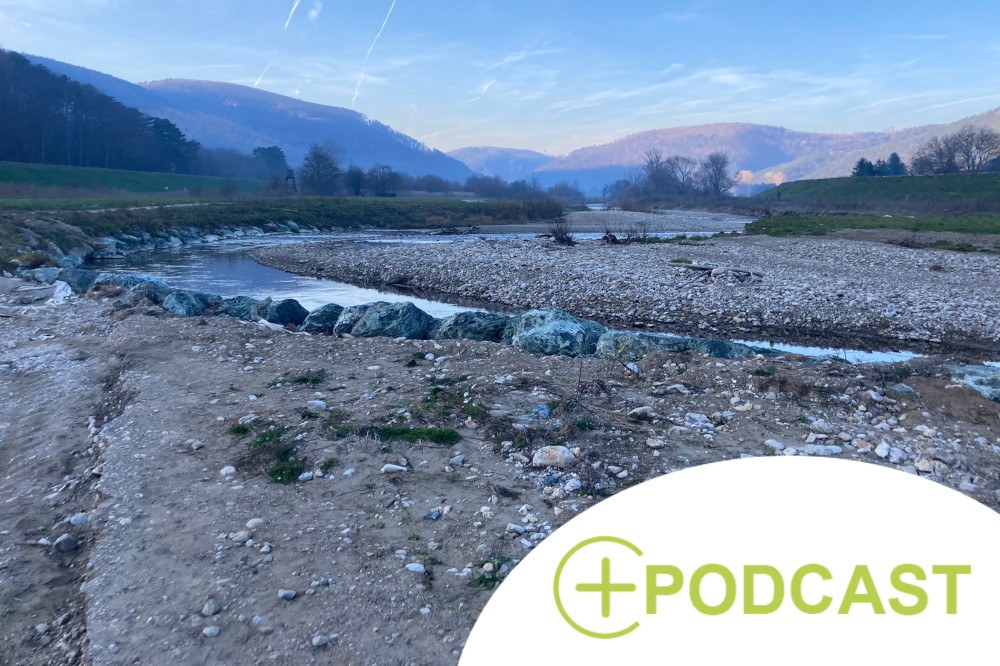Too much water, too little water: excursion to the Vienna Woods
How do drones detect illegal campfires? How do settlements protect themselves from the next flood? What do forest fires have in common with avalanches? At the end of November 2024, an excursion to the Vienna Woods Biosphere Reserve by participants in the MultiBios project looked for answers.
Through education and networking, biosphere reserves make an important contribution to dealing with climate risks. In the MultiBios project, in which CIPRA is involved, experiences are shared: at the end of November 2024, the project team visited a flood protection project in Triestingtal/A. A two-kilometre-long dam was being built right next to housing estates. In September 2024, a few months after construction was completed, a 100-year flood occurred. The dam held; critical voices were silenced. “The basin held and averted millions in damage”, says Mayor Daniel Pongratz. “We were all relieved.”
Forest fires and avalanches
A forest fire broke out in November 2021 south of the Vienna Woods, on the steep slopes around Schwarzau im Gebirge/A. “It was very hot at the time, dry as dust; the wind was blowing and you could see the fire spreading at immense speed”, explains forest manager Peter Lepkovicz in the MultiBios workshop. A campfire had started the fire, which destroyed an area of forest the size of 140 football pitches in just ten hours. Today, drones equipped with thermal imaging cameras fly over the region in search of illegal campfires. Deadwood, tree trunks laid crosswise and deliberately created gaps in the forest all help contain fires. Burnt forest areas should be used for education, says Verena Gruber: as a forest educator, she explores the Salzburg Lungau Biosphere Reserve with school classes and is a member of the avalanche warning commission: “Just like with avalanches, you have to appeal to people’s emotions, otherwise they won’t remember”.
Researching with those most affected
Bark beetles, storm damage, snow breakage: land users such as forestry and farming businesses are directly affected by such events. The MultiBios research team interviewed them in several biosphere reserves. Claudine Egger from the Institute of Social Ecology at the Vienna University of Natural Resources and Life Sciences explains that “the fact that the forest has to be reorganised” is important to many. Her colleague Peter Fichtinger interviewed land users in the Vienna Woods. Prolonged dry spells on the one hand and heavy rainfall on the other – this is a complex issue where relatively little can be done technically. “Tackling problems like this requires a systemic view at regional level”, says Fichtinger.
Sources and further information:
www.cipra.org/multibios (de, fr, it, sl), https://noe.orf.at/stories/3258462/ (de), www.derstandard.at/consent/tcf/story/2000130726488/waldbrand-im-rax-gebiet-verhaeltnismaessig-ruhige-nacht-aber-keine-entwarnung (de), www.biosphaerenpark.eu/workshop-wienerwald-multibios-projekt (de), https://boku.ac.at/wiso/sec (de, en), https://www.bpww.at/de (de, en), https://nationalpark.ch/about/netzwerke/biosphaerenreservat/forschung/ (de), https://biosphaerenpark.vulkanland.at/kommunikation/forschungsprojekt-zu-naturgefahren-multibios/ (de), https://forschung.boku.ac.at/en/projects/15335 (en)
Listen to the CIPRA podcast on the excursion:
(in German)





